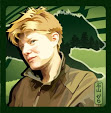 Most of you probably haven't heard of Splashdown. My sister discovered them back in the 90's so I've been listening to them for about 8 years now. Sadly, difficulties with their first major label resulted in there being no major label releases of material as well as the demise of the band itself.
Most of you probably haven't heard of Splashdown. My sister discovered them back in the 90's so I've been listening to them for about 8 years now. Sadly, difficulties with their first major label resulted in there being no major label releases of material as well as the demise of the band itself.Splashdown independently released three+ albums worth of stuff before this happened and a fourth album worth of material (with a lot of remixes - one by Rhys Fulber!) after. The songs were never signed over and rather than have them moulder on some shelf, the band has given permission for their songs to be freely downloaded online.
This is the point of my post.
You can download their entire discography HERE. That's roughly 50 songs.
It's hard to describe them. Splashdown is a 3-piece with female vocalist. Their music is described as a unique mix of electronica, rock, jazz, with middle-eastern influences. Melissa Kaplan's vocals are kind of jazzy with the ability to flit from note to note with middle-eastern dexterity. The bass is dynamic and at times jazzy. Crunchy percussion/keyboards can be Björk-esque. I can't think of anyone they really sound like.
If I have you, I recommend listening to these songs for a taste:
"Halfworld" from the Halfworld EP
"Charming Spell" from the Redshift EP
"Mayan Pilot", "Dig" are both more jazzy, from Blueshift
"Elvis Sunday", "Games You Play" are more pop-rock from Blueshift
"Waterbead" from Blueshift & "Beguiled Mark II" from the Halfworld EP are both crunchy electronica/rock
"Karma Slave" - good aggressive, grungy rock sound
"Asia at Odd Hours" from Possibilities is more electronica pop, more polished
There are multiples of several of the songs - they're all different versions. Like, I prefer the original "Ironspy" (Halflife) to the newer one (Blueshift) because it has more grit (very subtle). Also, "Beguiled" was redone as a gutsy, dark song that is mostly percussive in "Beguiled Mark ii" - the revision being much much better.
Anyway - it's sad to see such an awesome band's music left adrift on the net. It's really solid stuff and it is beyond many of their fans that they were not signed earlier in their career. But at the time there wasn't anyone else really like them that I could think of and the music industry has been playing it really safe since the mid 90's and arguably earlier.
If you like strong female vocals with a slight jazz edge, electronic crunch, dynamic and interesting bass lines driving everything, you might like Splashdown. Some of their songs like "Presumed Lost", "I Understand", and "Lost Frontier" sound like they could of been on the radio - they have that air of familiarity, so at first glance they seem radio-friendly but you start checking out the rest of their stuff and you see they're really kind of unique. IMHO. ;)
And hell, it's FREE. :D





